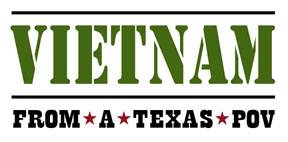
SEPTEMBER 1—JANUARY 31, 2005
VIETNAM FROM A TEXAS POINT OF VIEW
SOUTHWESTERN WRITERS COLLECTION
VIETNAM FROM A TEXAS POV: Q & A
Here are the questions (and answers) that can also be found by viewing the exhibit.
1. True or False: The United States repeatedly tried to assassinate Vietnamese Communist leader Ho Chi Minh.
Answer: False. In fact, U.S. forces may have saved Ho Chi Minh's life in 1945. A team of Americans parachuted into northern Vietnam to treat the ailing Ho Chi Minh for malaria and dysentery. "Uncle Ho," as he was known to millions of Vietnamese, had been leading the nationalist resistance to Japan during World War II.
2.True or False: President John F. Kennedy was the first US president to send troops into Vietnam.
Answer: False. President Dwight D. Eisenhower pledged support to South Vietnam in 1954 after the French were defeated and forced to give up their colony. The U.S. began suffering military casualties by 1956.
3. What is the difference between "Vietnam" and "Viet Nam"?
Answer: "Vietnam"- a single word-is the Westernized spelling of "Viet Nam." Viet Nam is how the Vietnamese themselves refer to their country.
4. True or False: During the Vietnam War, American teenagers from poor families were three times more likely to be drafted than children from wealthy families.
Answer: False. Children from poor families were twice as likely to be drafted. Once drafted, however, they were twice as likely to be assigned to combat units than eligible children from wealthy families.
5. True or False: A "Bouncing Betty" was a trip-wire mine that, once activated, jumped up into the air and exploded at groin height.
Answer: True. Mines were a particular concern to American combat troops. 11% of deaths in Vietnam were attributable to mines.
6. Michael Rodriguez kept a commemorative cigarette lighter from his 1966-1967 tour in Vietnam as a Marine. What is inscribed on the lighter?
A. "The Marlboro Man is Dead."
B. "Kill a Commie for Mommie."
C. "For those that fight for it, Life has a flavor the protected never know."
D. "What are we fighting for?"
Answer: C. "For those that fight for it, Life has a flavor the protected never know."
7. ABC-TV objected to and requested a rewrite for which element of a China Beach script in 1988?
A. Avoid any shot featuring wounds
B. Keep blood effects to a minimum
C. Substitute "Gee" for "Geez"
D. Delete "Jesus Christ" from a character's dialogue
E. All of the Above
Answer: E. All of the Above
8. Which Texan (and later novelist of the Vietnam War) received a letter from Lyndon B. Johnson congratulating him on his acceptance into Naval Reserve Officer Training?
Answer: James Crumley
9. Mark Busby graduated from Officer Candidate School at Fort Benning in May 1970. What momentous domestic event occurred that same month?
A. The assassination of Bobby Kennedy.
B. News of the My Lai massacre was revealed to the public
C. The first lunar landing
D. The Kent State massacre
Answer: D. The Kent State massacre. At Kent State University on May 4, 1970, National Guard troops on campus fired upon anti-war protesters, killing four students and wounding nine.
10. True or False: While in college in the late 1960s, novelist Sarah Bird formed an anti-war organization called "Damsels in Dissent."
Answer: True. Bird founded the organization at the University of New Mexico. The group counseled draft candidates on how to fool induction center doctors by eating balls of tinfoil and putting laundry soap in their armpits.
11. True or False: True Magazine featured Texas novelist and college professor-turned-war correspondent Robert Flynn on its January 13, 1971 cover, hailing Flynn's heroism.
Answer: False. Although Flynn received his press credentials from True, he never published any stories in the magazine. Flynn's reporting from Vietnam remained unpublished until 1989, when it was issued by Texas A&M Press as A Personal War in Vietnam.
12. Who wrote the following? "Vietnam was the first rock-and-roll war, a weird mix of sex, drugs, music, violence, and idealism that was the dark mirror of the sixties. For the men who fought there, it was also an intense sharing of comradeship and trust, a Woodstock with weapons."
Answer: William Broyles, Jr. From Brothers in Arms: A Journey from War to Peace
Related Links:



- Facebook
- Twitter
- Instagram
- Youtube
Email List